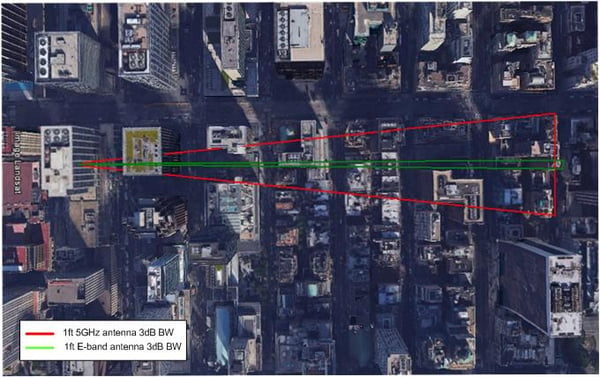I’m about to tell you why millimeter waves are the best thing since sliced bread: how they provide high capacity, are immune to interference and suitable for dense deployment and no, you don’t lose your shirt when you deploy a link.
In this article, I’ll explain the 3 main advantages of using millimeter frequency bands (V-Band and E-Band) for wireless connectivity.
Digital wireless communication has been around for quite a while. When Homo sapiens in prehistoric times wanted to transmit a danger signal over a long distance, they just lit a fire on a hill. That was first binary transmitted signal, BPSK or on-off keying if you wish. You may argue that capacity was not very large and a hungry family just grilling their mammoth may have been a misleading signal. Right. Now let me show you how communication technology has evolved.
How is it that millimeter wave (mmWave) frequencies can provide very high capacities?
Practically, there are two frequency bands called millimeter waves (mmWave): E-Band and V-Band. In US, for instance, E-Band has 10 GHz of available spectrum: 71-76 GHz paired with 81-86 GHz, while V-Band has “only” 7GHz of free spectrum. In fact, V-Band has more free frequency than all unlicensed bands put together. This huge amount of bandwidth, allows to utilize wide channels, 250MHz, 500MHz or even larger. Using simple modulation schemes on these channels provides true and reliable Gigabit capacity and even beyond.
Why are millimeter waves immune to interference?
There are several things happen, when you climb up the frequency range. First, according to the Friis formula, signal attenuation increases. On the other hand, the antenna (for a given size) becomes more directive, which means it provides more gain.
Let’s try to plug in some numbers:

Table 1: Free space loss at 5GHz and 75GHz
At high frequencies, the electromagnetic signal transmitted is more focused and the interference signals that leak via antennas side lobs are highly attenuated by both low side lobs and high free space loss.
Once again, let’s do the math, for a typical 1ft antenna:

Table 2: 1ft antenna characteristics at 5GHz and 75GHz

Figure 1: Comparison of E-band vs. 5GHz in dense urban environment
There is virtually no interference in these bands and they are extremely suitable for dense deployment. On top of this, there are nine different 500MHz channels in E-Band frequency band and with two available polarizations, your network performance will be rock solid.
Why do millimeter wave links cost so little?
There are two aspects related to the cost: OPEX and CAPEX.
Let’s start with OPEX. We just explained why these bands are immune to interference. That means no radio planning is required, and therefore, no work for the regulator! You got it – spectrum license fees range from very low to absolutely none. The second component is the installation, using proprietary alignment mode and simple tools it is a 15 minute install-and-go kind of thing.
Now, the CAPEX. The technology has advanced, and instead of bulky and heavy split mount radios you get very compact, highly integrated, all-outdoor units. These all-outdoor units include all the radio components, networking devices and an integrated antenna. The small number of components and deep silicon integration, make the equipment cost affordable even for home users.
The bottom line
The bottom line is that millimeter wave (mmWave) frequencies can provide you real Gigabit capacity, slightly more than a fire signal I would say, You install it once and it will tick forever, and it won’t cost you much. Don’t you think you should give it a try?


